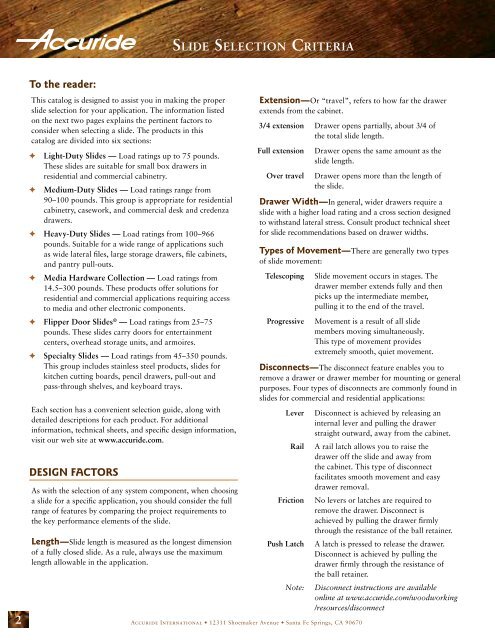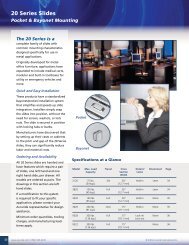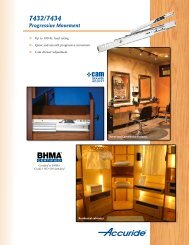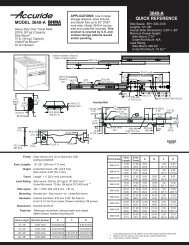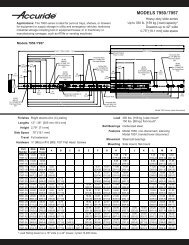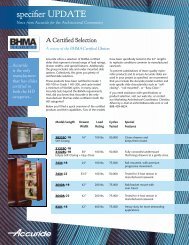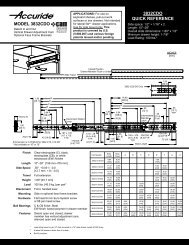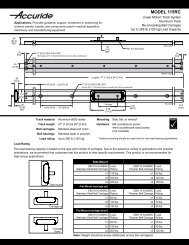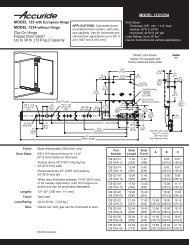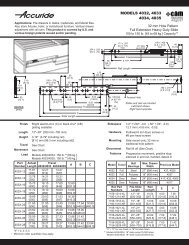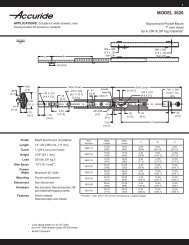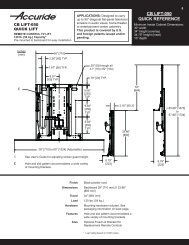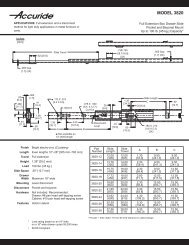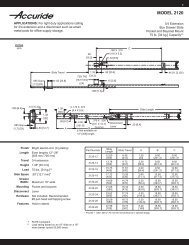Precision Ball Bearing Slide Products For Wood Furniture ... - Accuride
Precision Ball Bearing Slide Products For Wood Furniture ... - Accuride
Precision Ball Bearing Slide Products For Wood Furniture ... - Accuride
You also want an ePaper? Increase the reach of your titles
YUMPU automatically turns print PDFs into web optimized ePapers that Google loves.
To the reader:<br />
This catalog is designed to assist you in making the proper<br />
slide selection for your application. The information listed<br />
on the next two pages explains the pertinent factors to<br />
consider when selecting a slide. The products in this<br />
catalog are divided into six sections:<br />
F Light-Duty <strong>Slide</strong>s — Load ratings up to 75 pounds.<br />
These slides are suitable for small box drawers in<br />
residential and commercial cabinetry.<br />
F Medium-Duty <strong>Slide</strong>s — Load ratings range from<br />
90–100 pounds. This group is appropriate for residential<br />
cabinetry, casework, and commercial desk and credenza<br />
drawers.<br />
F Heavy-Duty <strong>Slide</strong>s — Load ratings from 100–966<br />
pounds. Suitable for a wide range of applications such<br />
as wide lateral files, large storage drawers, file cabinets,<br />
and pantry pull-outs.<br />
F Media Hardware Collection — Load ratings from<br />
14.5–300 pounds. These products offer solutions for<br />
residential and commercial applications requiring access<br />
to media and other electronic components.<br />
F Flipper Door <strong>Slide</strong>s ® — Load ratings from 25–75<br />
pounds. These slides carry doors for entertainment<br />
centers, overhead storage units, and armoires.<br />
F Specialty <strong>Slide</strong>s — Load ratings from 45–350 pounds.<br />
This group includes stainless steel products, slides for<br />
kitchen cutting boards, pencil drawers, pull-out and<br />
pass-through shelves, and keyboard trays.<br />
Each section has a convenient selection guide, along with<br />
detailed descriptions for each product. <strong>For</strong> additional<br />
information, technical sheets, and specific design information,<br />
visit our web site at www.accuride.com.<br />
DESIGN FACTORS<br />
As with the selection of any system component, when choosing<br />
a slide for a specific application, you should consider the full<br />
range of features by comparing the project requirements to<br />
the key performance elements of the slide.<br />
Length—<strong>Slide</strong> length is measured as the longest dimension<br />
of a fully closed slide. As a rule, always use the maximum<br />
length allowable in the application.<br />
<strong>Slide</strong> Selection criteria<br />
Extension—Or “travel”, refers to how far the drawer<br />
extends from the cabinet.<br />
3/4 extension Drawer opens partially, about 3/4 of<br />
the total slide length.<br />
Full extension Drawer opens the same amount as the<br />
slide length.<br />
Over travel Drawer opens more than the length of<br />
the slide.<br />
Drawer Width—In general, wider drawers require a<br />
slide with a higher load rating and a cross section designed<br />
to withstand lateral stress. Consult product technical sheet<br />
for slide recommendations based on drawer widths.<br />
Types of Movement—There are generally two types<br />
of slide movement:<br />
Telescoping <strong>Slide</strong> movement occurs in stages. The<br />
drawer member extends fully and then<br />
picks up the intermediate member,<br />
pulling it to the end of the travel.<br />
Progressive Movement is a result of all slide<br />
members moving simultaneously.<br />
This type of movement provides<br />
extremely smooth, quiet movement.<br />
Disconnects—The disconnect feature enables you to<br />
remove a drawer or drawer member for mounting or general<br />
purposes. Four types of disconnects are commonly found in<br />
slides for commercial and residential applications:<br />
Lever Disconnect is achieved by releasing an<br />
internal lever and pulling the drawer<br />
straight outward, away from the cabinet.<br />
Rail A rail latch allows you to raise the<br />
drawer off the slide and away from<br />
the cabinet. This type of disconnect<br />
facilitates smooth movement and easy<br />
drawer removal.<br />
Friction No levers or latches are required to<br />
remove the drawer. Disconnect is<br />
achieved by pulling the drawer firmly<br />
through the resistance of the ball retainer.<br />
Push Latch A latch is pressed to release the drawer.<br />
Disconnect is achieved by pulling the<br />
drawer firmly through the resistance of<br />
the ball retainer.<br />
Note: Disconnect instructions are available<br />
online at www.accuride.com/woodworking<br />
/resources/disconnect<br />
<strong>Slide</strong> Profiles—More than one slide profile (or height)<br />
may be appropriate for a given application. <strong>Accuride</strong> provides<br />
several low-profile design options for applications in which a<br />
smaller profile would enhance the appearance of the completed<br />
unit.<br />
LOAD FACTORS<br />
Load Rating—Most <strong>Accuride</strong> slides are tested a minimum<br />
of 50,000 cycles in accordance with the guidelines of all<br />
applicable ANSI/BIFMA specifications, or as appropriate for<br />
some moderate use applications. See the product technical<br />
sheet for specific information regarding test criteria.<br />
Thorough testing means that you can count on <strong>Accuride</strong><br />
slides to meet industry-accepted criteria.<br />
Our slides are rated for the dynamic load that an 18" pair<br />
will carry without failure (load rating decreases proportionally<br />
beyond the 18" length). In all cases, the static (resting)<br />
load capacity of each model is at least twice the load rating,<br />
providing at minimum a 100% static safety factor, even<br />
when the slide is loaded to its maximum rating. Because slide<br />
performance may be affected by factors unique to a specific<br />
application, always test slides in the intended application.<br />
Flat Mounting—<strong>For</strong> optimal slide performance, mount<br />
slides only as indicated in the catalog or on the technical<br />
sheet. Certain slides may be mounted flat under a drawer,<br />
but the resulting load rating will be at least 50% less than<br />
the load rating applicable to the same pair of slides mounted<br />
vertically on the side of the drawer. Please consult the product<br />
technical sheet for specific flat-mount load rating information.<br />
Shock/Vibration—Subjecting slides to shock and<br />
vibration may adversely affect the performance.<br />
Applications that are subject to these conditions should<br />
be tested to evaluate the affect on slide performance.<br />
If conditions are severe, select a heavier-duty slide.<br />
APPLICATION FACTORS<br />
Unit Construction—When installed in a drawer or<br />
cabinet that is lightweight and flexible, drawer slides can<br />
contribute to the structural rigidity of the unit. To ensure that<br />
the slide is able to provide this support, select a model with a<br />
slightly higher load rating and larger cross section than you<br />
would ordinarily need for the application.<br />
Installation—Most slides are designed to be mounted in<br />
pairs on the sides of drawers or moving unit. When installing<br />
slides, exercise care to ensure that they are mounted parallel<br />
to each other, in vertical and horizontal axes.<br />
Before mounting slides other than as designed, carefully<br />
consider any potential adverse effects on the slide and, if<br />
necessary, consult the factory. <strong>For</strong> example, mounting slides<br />
flat under the drawer, rather than on the side, will lower the<br />
load rating by at least 50%, but mounting a slide high on one<br />
side and low on the other side will have little adverse effect<br />
on load rating. Be sure to evaluate the mounting scheme<br />
thoroughly and test as needed. Not all slide models can be<br />
used in flat-mount applications.<br />
ENVIRONMENTAL FACTORS<br />
Unless otherwise stated, <strong>Accuride</strong> slides are designed for<br />
indoor use and should be protected from excessive moisture,<br />
chemical fumes, dirt, and corrosion. The <strong>Accuride</strong> self-cleaning<br />
ball retainer protects slide raceways by removing foreign<br />
particles between ball bearings, and the lubricant provided is<br />
sufficient for normal slide life. Use care when applying finishing<br />
agents because the overspray may affect slide movement.<br />
Should you need to clean the slides, you can re-lubricate them<br />
with a quality grease rated “EP” for extreme pressure.<br />
Extreme temperatures can also affect the lubricant and<br />
plastic or rubber components. Commercial drawer slides<br />
are designed to be used for extended periods in temperatures<br />
between 0 and 180 degrees Fahrenheit. <strong>For</strong> service outside<br />
normal temperature and humidity ranges, consult the factory.<br />
TEChNICAL SUPPORT<br />
Please visit the Technical Resources section on our<br />
web site at www.accuride.com for the most current<br />
technical information.<br />
<strong>For</strong> further assistance, use the online Technical Support<br />
Request or send an e-mail to technical@accuride.com.<br />
2 3<br />
<strong>Accuride</strong> International • 12311 Shoemaker Avenue • Santa Fe Springs, CA 90670 Telephone: 562 903-0200 • Fax: 562 903-0208 • E-mail: info@accuride.com • www.accuride.com


